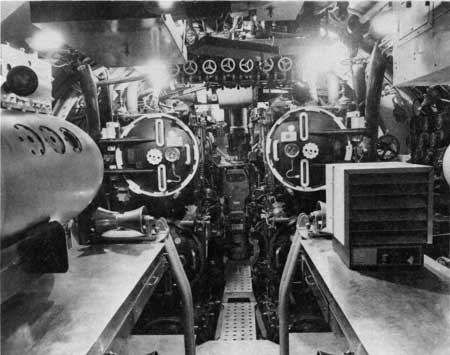MENU
![]() Submarines
Submarines
|
Warships Associated With World War II in the Pacific USS LIONFISH |

|
|
Submarines |
Balao class |

USS Lionfish, forward torpedo room, Fall River, MA
(Photo by USS Massachusetts Memorial Committee, 1984)
| Name: | USS Lionfish (SS-298) |
| Location: | Battleship Cove, Fall River, Massachusetts |
| Owner: | USS Massachusetts Memorial Committee, Inc. |
| Condition: | Excellent, unaltered |
| Displacement: | 1,500 tons (surface) / 2,415 tons (submerged) |
| Length: | 312 feet |
| Width: | 27 feet |
| Machinery: | Diesel-Electric |
| Maximum Speed: | 20 knots (surface) / 9 knots (submerged) |
| Maximum Depth: | 712 feet [1] |
| Armament: | Ten 21" torpedo tubes (6 forward, 4 aft), twenty Mark 14 torpedoes or twenty-four Mark 18 electric torpedoes, one 5"/25 caliber deck gun, one 40mm gun, one 20mm gun, and four .50 caliber machine guns.
The ship was originally armed with two 5-inch deck guns, two 40 mm guns and ten 21-inch torpedo tubes. [2] |
| Crew Size: | 76 officers and enlisted men |
| Builder: | Cramp Shipbuilding Company, Philadelphia, Pennsylvania |
| Launched: | November 15, 1944 |
| Commissioned: | |
Description
USS Lionfish, (SS 298), was laid down by the Cramp Shipbuilding Corporation of Philadelphia in December 1942. Because of production delays the Cramp Shipbuilding Corporation was unable to complete her so she was towed to Portsmouth, New Hampshire, to be completed. She was launched November 15, 1944.
USS Lionfish is a representative of the Balao class of fleet submarines used in World War II. The deck is made of teakwood, and the submarine's exterior is painted black and haze gray. She is a pre-snorkle type submarine, operating underwater on batteries, and powered by four engines in a diesel electric system delivering 6,500 horsepower. [3]
The crew consisted of 76 officers and enlisted men who were berthed in every available inch of space, including over the torpedo tubes. The ship escaped the guppying process (the complete exterior and interior alteration that most World War II submarines experienced after the war) and retains its original design and fittings. [4]
USS Lionfish is semi-permanently moored in Battleship Cove on the Taunton River just north of the Braga Bridge. It is protected to the east by filled land and a high embankment and is bordered to the north by USS Joseph P. Kennedy, Jr. and to the west by USS Massachusetts. [5]
Role of the Submarine in World War II
In the conflict against Japan in World War II, the role and importance of submarine forces of the United States cannot be overestimated. American sub marines sank more than 600,000 tons of enemy warships and more than 5,000,000 tons of merchant shipping, thus destroying much of Japan's ocean commerce, This was accomplished by a force that never numbered more than two percent of naval personnel engaged in the war. The American submarine war against Japan created a blockade that denied her the oil, iron ore, food, and other raw materials she needed to continue to fight. By 1945 this submarine war made it impossible for any Japanese ship to sail the ocean. Without this commerce and the raw materials it supplied to her war effort, Japan found it impossible to continue the war outside of the homeland. [6]
USS Lionfish represents the U.S. submarine forces that fought against Japan in World War II in the following respects:
- USS Lionfish is an intact example of the standard fleet type Balao-class submarine that played an important part in World War II.
- USS Lionfish made two war patrols in the Pacific and is believed to have sunk an I-Class Japanese submarine and a 100-ton schooner. She received one battle star for World War II Service.
- USS Lionfish is maintained in excellent physical condition and is displayed at Battleship Cove, Massachusetts, with the battleship USS Massachusetts and the destroyer USS Joseph P. Kennedy, Jr. Displayed in the bunkroom of USS Lionfish is a memorial to the 52 American submarines lost during the war.
Footnotes
1. USS Massachusetts Memorial Committee, Inc. USS Lionfish-Physical Description (Fall River, Massachusetts: USS Massachusetts Memorial Committee, Inc., 1984), p. 1.
2. Christine Boulding, "National Register of Historic Places inventory USS Lionfish" (Boston, Massachusetts Historical Commission, 1976), p. 2.
6. Drew Middleton, Submarine--The Ultimate Navy Weapon-Its Past, Present, and Future (Chicago, Illinois: Playboy Press, 1976), pp. 109-12.
Edwin P. Hoyt, Submarines at War--The History of the American Silent Service (New York: Stein and Day, 1983), pp. 297-98.
Richard H. O'Kane, Clear the Bridge (New York: Bantam Books, 1981), pp. 465-67.
Bibliography
Blair, Clay Jr. Silent Victory--The U.S. Submarine War Against Japan. Philadelphia, Pennsylvania: J.B. Lippincott Company, 1975.
Boulding, Christine. "National Register of Historic Places Inventory USS Lionfish." Boston, Massachusetts: Massachusetts Historical Commission, 1976.
Hoyt, Edwin P. Submarines at War--The History of the American Silent Service. New York: Stein and Day, 1983.
Middleton, Drew. Submarine--The Ultimate Naval Weapon-Its Past, Present and Future. Chicago, Illinois: Playboy Press, 1976.
O'Kane, Richard. Clear the Bridge. New York: Bantam Books, 1981.
Roscoe, Theodore. United States Submarine Operations in World War II. Annapolis, Maryland: United States Naval Institute, 1965.
USS Massachusetts Memorial Committee, USS Lionfish. (Physical Description) Fall River, Massachusetts, 1984.
Photographs
(click on the above photographs for a more detailed view)
 Top
Top
Last Modified: Fri, Aug 25 2000 12:00:00 pm PDT
http://www.cr.nps.gov/history/online_books/butowsky1/lionfish.htm
![]()




